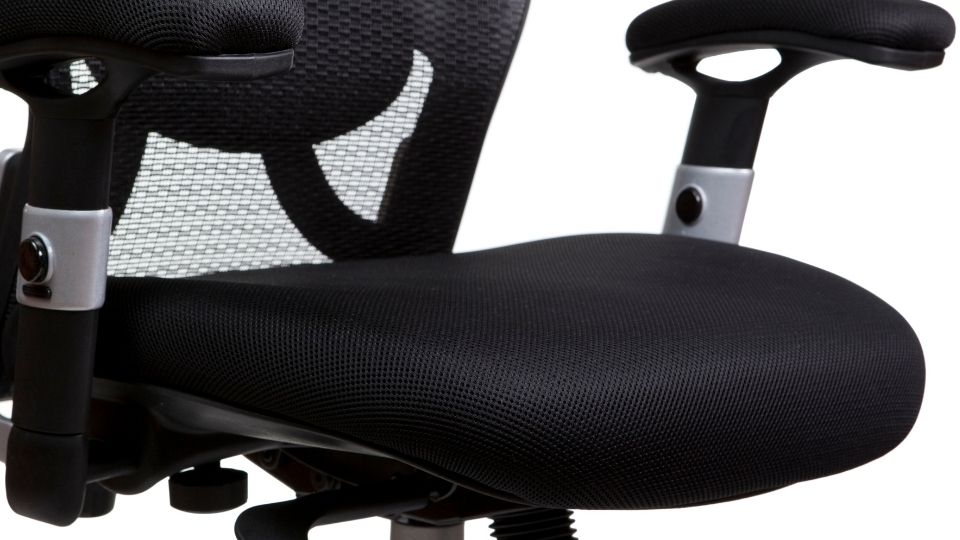What Makes a Comfortable Chair?
It is not a coincidence that most people in the workplace have an ergonomic chair. These chairs are designed to make sitting more comfortable for employees and improve their productivity while they work. Ergonomic chairs should be customised to fit your body, your needs, and your lifestyle. The goal of these chairs is to promote healthy posture so you can avoid back pain or injuries from sitting too long at work.
As a general rule, for a chair to be comfortable, it should have adjustable features, including seat height and depth, forward tilt, armrests and headrests, as well as lumbar support. Seat materials should provide adequate support for the lower back and promote a healthy posture.
In my clinical experience as an ergonomic adviser to many companies, I found that an uncomfortable chair can be the biggest distraction during the working day. For those who sit at desks all day, an uncomfortable seat will not only make the workday more difficult but also lead to back and potential health problems.
When you’re sitting in a chair, do you ever notice how your back feels after? Or maybe when standing up from the chair and walking around for a while, can you feel the discomfort of sitting too long? If this sounds like you, then it’s possible that your work chair is not comfortable enough. This article will go over what to look for in an office or home chair and some tips on making sure that your next purchase is the perfect one!
All Day Comfort & Support
There are many different varieties of office chairs, and it can be difficult to decide which one is the best for you. It all depends on what your needs are. If you work in an office that has a lot of sitting time, then there’s no question — go with a fully adjustable ergonomic chair so that you’re comfortable while working. If you have back problems, we will dig a little deeper in this article to show you what components your chair must have so that it will support your spine better than most other seats would.
Chairs for Back Pain: 4 Important Features
The four most important components of a chair for a comfortable chair are height, seat depth, forward tilt, and reclining. The best chairs for people with back problems have a high enough seat to keep their lower backs from slouching forward while sitting. This is helpful in reducing back strain by giving support to the spine.
1. Seat depth
The seat depth is an important factor for back pain sufferers because it will affect the person’s ability to maintain a neutral spine while sitting. A chair that doesn’t come up too high on their thighs and has enough legroom should help with this issue. The third most important part of a good chair is for people with chronic low-back problems.
2. Seat Height
Getting the seat height right is an important feature for chair comfort. For people with back problems, the seat should be high enough to keep their lower backs from slouching forward while sitting. In general, a chair that doesn’t come up too high on their thighs and has enough legroom will help with this issue.
Black Friday: 35% Off Today
Typical Delivery 1-3 Days
3. Forward Tilt
The third most important part of a good chair for people who want to avoid chronic low-back pain is the forward tilt adjustment. By tilting your hips forward, you can help to correct the natural slouching posture that your body assumes when you sit for long periods of time.
A chair for chronic back pain should have a hip tilt because it can help to correct the natural slouching position that your body will assume when sitting. The hips always need to be higher than the knees, and some standards recommend up to 20° of forwarding lean (in order) to keep you from feeling pressure in your lower spine while also keeping good posture healthy as well. (Some people write 0-4 degrees).
By adjusting seat angles on chairs at our discretion, we are able to reduce or eliminate contact with pressure points that may exist due to being seated too long. Healthier blood circulation is promoted by this technique as well!
4. Chair Recline
The final thing to consider is how well it accommodates a variety of other postures, like leaning back or reclining. If you have low-back pain and are inclined to lean forward while sitting (as many people do) you will put too much pressure on your spinal discs which may lead to back pain. The perfect posture is a moving posture that can be accomplished with intermittent reclining.
How to Make Your Chair More Comfortable
When you are seated, your knees should be at approximately a 110-degree angle and the seat height should allow for this. In other words, your hips need to be higher than your knees. The best way to achieve this is with your forward tilt adjustment. If you have a chair where the seat height cannot be adjusted, like one of those retired desk chairs from your high school English class or something similar, then consider getting a seat wedge (with a thicker part to the back of the seat).
All Day Comfort & Support
Replacing your gas shock cylinder to match your height and weight is a fantastic way to upgrade your comfort with very little effort and cost. A new shock cylinder will give your seat an extra bounce which is good for your discs!
One of the most important things to do when buying a new chair is to get one that fits your body. Your shoulders should be able to fit in between armrests, and you should have ample room under the desk for feet with enough clearance from a seat at all times. All of these features will make it more comfortable for users who want to improve their work environment.
How Would You Describe a Comfortable Chair?
It may sound odd to think about the word “comfortable” when it comes to a chair, but in reality, you spend more time sitting than anything else. So if your office chair is not comfortable and causes back pain or other injuries, then it’s definitely worth looking into.
Black Friday: 35% Off Today
Typical Delivery 1-3 Days
Comfortable Office Chair for Long Hours
My clinical experience has shown me that a pair of safety features for sitting for extended periods is the back of the chair and armrests. Getting these two components perfect will make you more comfortable and allows you to maintain good posture which can help prevent future injuries like carpal tunnel syndrome or other repetitive strain injuries from happening in the first place.
The back of your chair should incorporate a lumber curve to cradle your lower back, and the armrests should be adjustable depending on what height, width, forearm length, and pivot suits you best. You will find it more comfortable when your arms rest at an angle at your sides rather than straight out. Aside from the fact that your armrests should be two centimetres higher than the desk, another important point is that your armrests should be closer to exactly six inches away from your desk.
However, if your desk is at a height that you can freely rest your arms on it without straining yourself then lower armrests may not be necessary. If the armrests are too low or too high, they will end up in an awkward position and might even cause strain to the wrists.
Takeaway
If you’re in the market for a new office chair, it’s important to understand what makes an ergonomic chair. The most useful guidance on this topic can be found by visiting my blog. I have compiled some articles that can help you avoid injuries and improve your productivity at work while sitting comfortably all day long. Could I interest you in learning more about how people sit at their desks or what are the best chairs for back pain?
Sources
- Thariq, M.M., Munasinghe, H.P. and Abeysekara, J.D., 2010. Designing chairs with mounted desktop for university students: Ergonomics and comfort. International Journal of Industrial Ergonomics, 40(1), pp.8-18.
- Goonetilleke, R.S. and Feizhou, S., 2001. A methodology to determine the optimum seat depth. International Journal of Industrial Ergonomics, 27(4), pp.207-217.
- Bendix, T., Winkel, J. and Jessen, F., 1985. Comparison of office chairs with fixed forwards or backwards inclining, or tiltable seats. European journal of applied physiology and occupational physiology, 54(4), pp.378-385.
- Cás, P.L.K.D., Vilanova, C.Q., Barcelos Jr, M.N.D. and Veras, C.A.G., 2012. Pneumatic Black and Chrome Gas Lift Spring Cylinder Piston for Office and Bar Chairs Parts. Journal of Aerospace Technology and Management, 4(3), pp.317-330.










